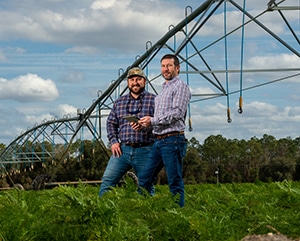Brooks Garland manages 4,500 acres of corn, 5,500 acres of peanuts, 300 to 400 acres of carrots in the off season and will try 1,600 acres of cotton this year for the first time. The Lee, Florida, operation started in 2004 with 1,500 acres and has grown to 12,000 acres.
As the farm has grown, so has the use of the 4R nutrient stewardship management practices. Garland readily admits he’s always been a conscientious farmer and continually looks for ways to improve operations.
“It all started by working with specialists from the University of Florida who helped us get 4R practices going on the farm,” Garland says. “David Royal with The Nature Conservancy also helped. What really opened my eyes were soil moisture probes. I started using those and began watering completely differently on corn and peanuts than I was before. I then realized that if you’re not using soil moisture probes, you’re watering off emotion.”
Rain and irrigation water flow quickly through the sandy soils in the region. Garland installed 37 soil moisture monitors with electrical conductivity sensors. He now knows the moisture content of his soil in 4-inch increments to a 24-inch depth.
The results? His team applies 250,000 fewer pounds of nitrogen and pumps 200,000 million fewer gallons of water to the farm each year.
After getting moisture in order, Garland turned to fertilizer timing and placement. Nutrients are applied six times during a growing season. The team starts with chicken litter in the fall. Starter fertilizer is next, then two passes using a toolbar fitted with 360 Y-Drops stream fertilizer on the soil next to plants. The remaining two applications are side-dressed dry fertilizer or fertigation. Weekly tissue tests determine plant nutrition needs.
Garland switched to precision corn planters about three years ago. He says he now focuses on singulation, depth, upforce and downforce and making sure the depth stays at exactly two inches.
“Yield has become more uniform and predictable in each pivot,” he says. His highest corn yield average was 227 bu/ac, but he averages 217 to 220 bu/ac across all corn acres.
Cover crops reduce wind erosion and take up leftover nitrogen.
Garland works with Keith Shaw, vice president of Mayo Ag Services in Mayo, Florida, to formulate much of his nutrient needs. They jointly use variable rate reports, crop and field examinations to determine application rates and timing.
“Brooks’ crew does a great job on timing and knowing every field,” Shaw says. “They are progressive in using new equipment and new application methods. Plus, they’re always willing to conduct a trial for a new product that may be more efficient. They do a jam up job – period.”
Best Practice Management
- Plant tissue testing to evaluate effectiveness of fertilizer and as a diagnostic tool when needed
- Use Adapt N nitrogen management tool
- Split nutrient application
- Grid soil sampling
- Use urease and nitrification inhibitors
